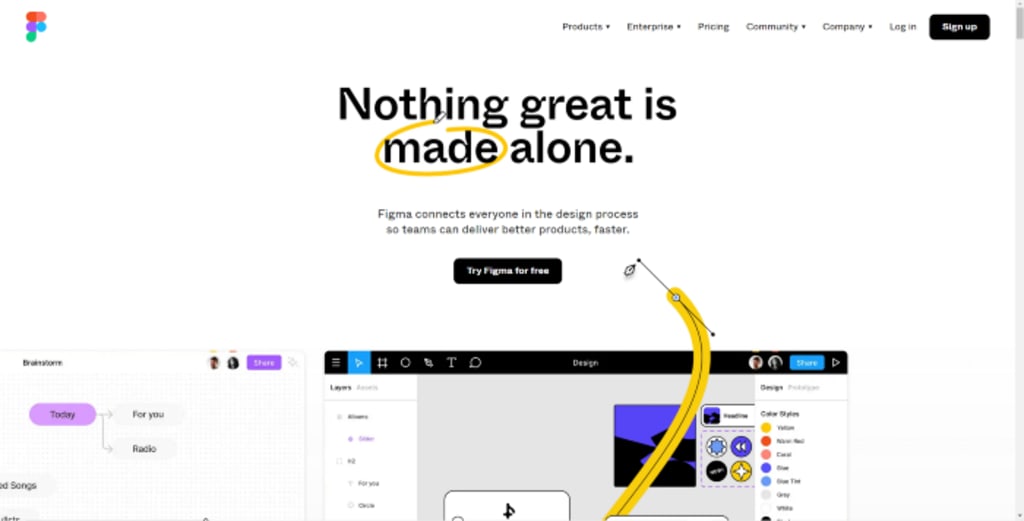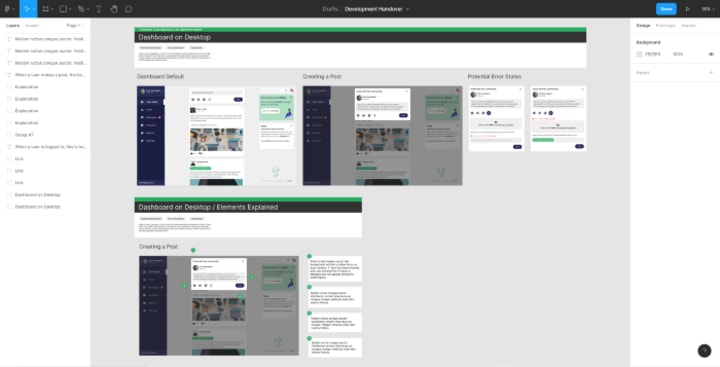Designers, please don’t use Figma to showcase your portfolio
Sharing your portfolio with the hiring team for the first time? Know your audience

I love Figma. I’ve loved it since its inception, I’ve loved it with each update and I’ve loved (and love) talking about it. I do my utmost to champion Figma for those that only know Sketch. What I don’t love however, is the number of junior designers sharing non-annotated Figma links via email to showcase work. As Lead UX Designer, I’m not the only decision maker in my team, so what may appear quirky to me appears as friction for others.
I clearly love Figma, but I can confidently say that not everyone shares my enthusiasm. Regardless of how good some applicants are, there’s a risk of rejection because there’s been no audience consideration. I might possibly understand the rationale — but will a recruiter? A CTO? A lead business analyst or senior product owner?
There’s always a danger in making assumptions, especially as a designer. If you’re applying for a new role, and aren’t 100% sure on the recipient, don’t use Figma to present your portfolio. Use a traditional portfolio instead.
Don’t use a sledgehammer to crack a nut

I understand the intricacies of Figma, and would consider myself a power user. I use it every day for my job. It’s a design tool that was made for people in my position. But outside of my position, using it as a means to communicate your design capabilities in the hopes of landing a new job, well, things can start to get tricky.
“I tried to look at this portfolio Chris, but I have to sign up to something called Figma? I don’t have the time,” a colleague would say.
Edit: A number of responses to this piece are rightly pointing out that an account to view work isn’t necessary. The point of this quote is to demonstrate that busy stakeholders assume that they *need* to sign up. As a result stakeholders can assume they’re not getting the full experience, and don’t give the portfolio the time it deserves. Furthermore, other designers may not have had this issue before, but that doesn’t mean the problem doesn’t exist. Know your audience!
During the hiring process, time is of the essence. If a designer applying for a new role has one opportunity to impress the hiring team, can they risk causing friction this early in the hiring process? I would argue not. Hiring teams want to click on a link to get instant access to work. A list of projects perhaps, a nice detailed breakdown of thought process, pain points, inputs, outputs. The classics.
What they’re more likely to see upon opening up Figma is this.

Without detailed instructions, it’s impossible to know where to begin. With detailed instructions, what’s the point? Wouldn’t a standard portfolio suffice? Now consider the CTO who’s always travelling. She pulls out her mobile phone, clicks the Figma link and sees, well, not a whole lot. Some non-descript icons, a list of layers — but most importantly not what she expected. Figma isn’t responsive.
A situation which should have been straightforward has become convoluted. Your decision to display your portfolio in Figma has created friction.
Again, I will likely know where to navigate and what you’re trying to showcase. It’s cute. I get it. But for your sake, do not do this. I’m probably the only person on the team who feels this way. Others will open the link, and ask me, “What is this Chris? Why would a candidate send unfinished work?” and I’d have to explain your reasoning. “It’s actually not unfinished, the candidate is using Figma — a tool we use — to demonstrate their thinking process.” At least, this is what I assume is your reasoning. Are you as a designer willing to risk someone else speaking for your work?
As first impressions go, the misunderstanding created here is huge. The seeds of doubt have been sowed. Part of being a designer is knowing your audience, and this potentially shows a lack of understanding. Worse, a lack of research into the company you’re applying for. We can’t assume everyone will know how to navigate a Figma project, so why try to reinvent the wheel?
Pro-tip: Present your portfolio the traditional way, but create a link to the Figma project if you want to show it in more detail!
Being a good designer is being a good communicator

If I’m not crafting some UI or interviewing users, I’m probably presenting. In the business world, consistency is key, and that means adapting my way of presenting to the needs of the many. I want to be able to communicate my ideas effectively so that everyone will understand them.
Ask yourself, “How much am I likely to gain by sending my portfolio though as a Figma project? Is this the best possible way that I can communicate my thought process, and why I’m the best candidate for this role?”
Effective communication is the most important soft skill in business today, and the bridge between designers and the rest of the company. By sharing a Figma link with little guidance, applicants subvert expectations and lose control of the narrative.
Figma will continue to evolve. Perhaps in the future it’ll be better suited to demonstrating portfolio work. But until then, traditional methods work best when trying to get your foot in the door.
Chris is a Lead UX Designer based in Belfast, Northern Ireland. He enjoys reading, writing and long walks in the wilderness. Reach out to him at [email protected].
About the Creator
Chris Kernaghan
2x Top Writer on Medium. Lead UX Designer. I write about design, gaming and what I’ve learned on planet Earth so far. Contact me — [email protected]
Enjoyed the story? Support the Creator.
Subscribe for free to receive all their stories in your feed. You could also pledge your support or give them a one-off tip, letting them know you appreciate their work.






Comments
There are no comments for this story
Be the first to respond and start the conversation.